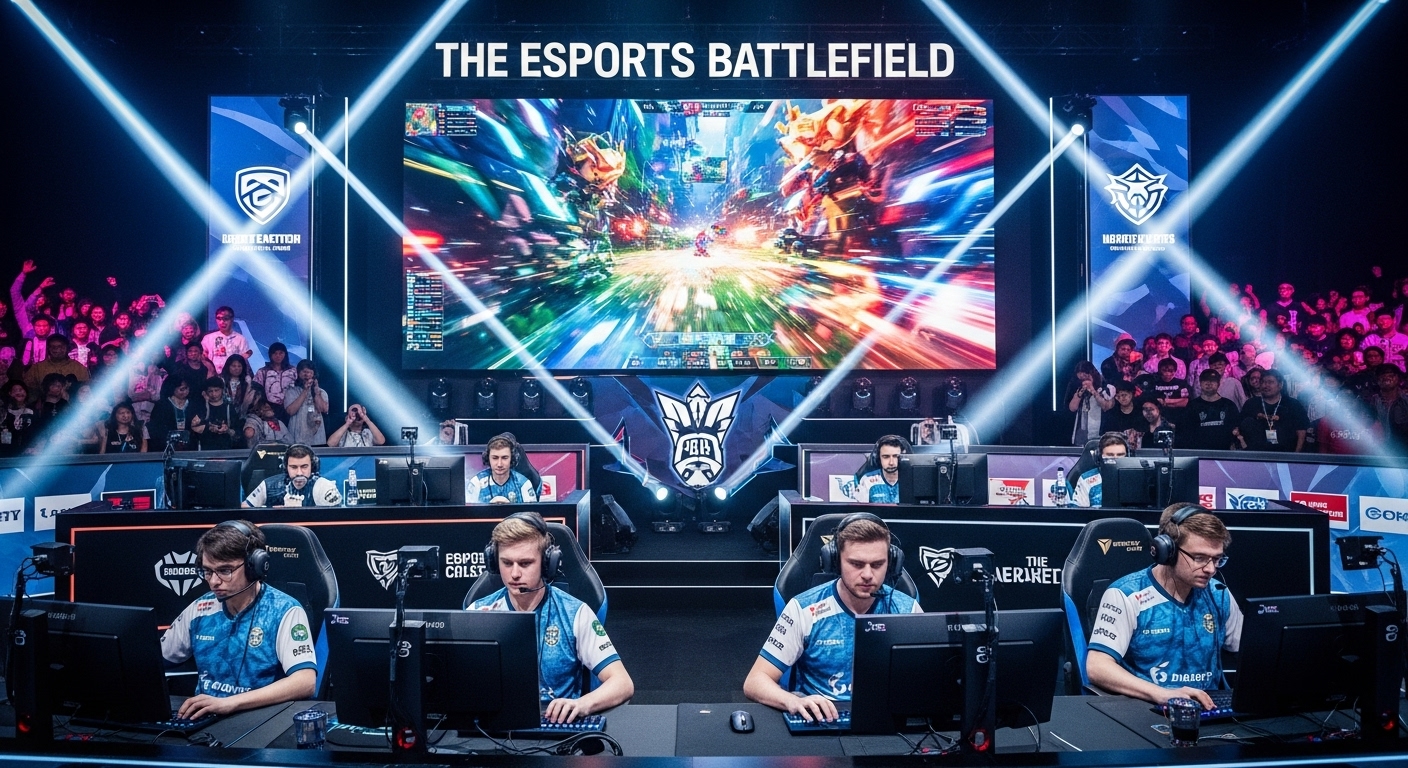Esports has evolved from a niche hobby to a global phenomenon that rivals traditional sports in both viewership and revenue generation. While the world of competitive gaming was once confined to basement tournaments and small LAN events, it is now a multi-billion-dollar industry with millions of passionate fans and a growing ecosystem that includes professional players, teams, sponsors, and media outlets. But how did we get here, and what does the future hold for esports? In this blog post, we will explore the rise of esports, its impact on the gaming and entertainment industries, and what we can expect in the coming years.
The Humble Beginnings: From Arcades to the Internet Age
To understand the incredible rise of esports, we need to look back at its origins. Competitive gaming didn’t appear overnight. The roots of esports can be traced to the late 20th century, when video games first gained popularity. The arcade era of the 1970s and 1980s was a crucial starting point for competitive gaming, as players would gather in arcades to compete for high scores in games like Space Invaders and Pong. These early competitions were informal and small in scope, but they laid the groundwork for a culture of competition in gaming.
The next significant step came in the 1990s with the advent of personal computers and online multiplayer games. Titles like Quake and StarCraft allowed gamers to connect over the internet and engage in competitive play on a global scale. These games introduced the concept of multiplayer online gaming, which would eventually become the foundation of modern esports.
The first true esports tournament that gained widespread recognition was the Red Annihilation tournament held for Quake in 1997. With a $1,000 prize and a large number of participants, this event marked the beginning of organized esports competitions. While it may seem small compared to today’s massive tournaments, Red Annihilation set the stage for future esports events and demonstrated that competitive gaming could attract serious players and audiences.
The Emergence of Professional Esports: Building the Framework
The early 2000s saw the rise of dedicated esports organizations, events, and global competitions. Games like Counter-Strike and Warcraft III were at the forefront of this movement, with tournaments like the World Cyber Games (WCG) and the Electronic Sports World Cup (ESWC) gaining international attention. These events established the competitive gaming ecosystem, complete with sponsorships, broadcasting deals, and prize pools.
In 2000, the World Cyber Games held its first competition, bringing together players from all over the globe to compete for a chance at international recognition and glory. The WCG’s success highlighted the potential of esports as a professional sport, and soon after, other tournaments followed suit. One of the most significant developments was the creation of Major League Gaming (MLG) in 2002, which would go on to host some of the biggest esports events in North America.
At the same time, esports began to shift from being a niche interest to a more mainstream activity. The growth of online streaming platforms like Twitch (launched in 2011) revolutionized the way people watched esports. For the first time, viewers could tune in to live broadcasts of tournaments and interact with players and commentators in real-time. This made it easier for fans to engage with their favorite players and teams, and it helped solidify the idea that esports was not just a hobby but a professional sport.
The Golden Age of Esports: The 2010s and Explosive Growth
The 2010s marked the golden age of esports. The industry experienced explosive growth, driven by the release of some of the most influential competitive games in history. Titles like League of Legends (LoL), Dota 2, Overwatch, and Counter-Strike: Global Offensive (CS:GO) formed the backbone of competitive gaming. These games introduced complex strategies, team dynamics, and competitive leagues that attracted both players and viewers in droves.
One of the key events that signified esports’ arrival in the mainstream was the League of Legends World Championship. Since its inception in 2011, the tournament has grown to become one of the largest and most-watched esports events in the world. By 2018, the LoL World Championship had attracted over 100 million viewers, surpassing traditional sports events like the Super Bowl in terms of viewership. This demonstrated the immense global appeal of esports and solidified its place as a staple in modern entertainment.
In addition to LoL, Dota 2’s The International tournament also played a significant role in the rise of esports. The prize pools for The International grew exponentially over the years, with 2018’s prize pool exceeding $25 million, crowning it as one of the largest in the history of competitive gaming. Crowdfunding through in-game purchases by fans contributed to this astronomical prize fund, a groundbreaking model that showcased the deep connection between esports organizations and their fanbase.
Meanwhile, new franchises like Overwatch League and Call of Duty League adopted a city-based model, similar to traditional sports leagues. These leagues brought a new level of organization and professionalism to esports, attracting investment from traditional sports owners and corporate sponsors. Esports was no longer seen as a fringe activity but as a legitimate business venture with massive potential.
The Business of Esports: Revenue Streams and Sponsorships
One of the most impressive aspects of esports’ growth is its ability to generate substantial revenue through multiple streams. The esports ecosystem is built on a mix of sponsorships, media rights, advertising, merchandise sales, ticket sales, and crowdfunding. Global brands like Coca-Cola, Intel, Red Bull, and Mercedes-Benz have all invested heavily in esports, recognizing the lucrative opportunities to connect with young, tech-savvy audiences.
Sponsorships have played a crucial role in the success of esports tournaments and teams. Brands are increasingly turning to esports as a way to engage with the coveted 18-34 demographic, which is often harder to reach through traditional advertising channels. Esports organizations and players also benefit from these sponsorships, receiving funding to cover costs related to salaries, travel, and event organization.
The rise of streaming platforms has also revolutionized how esports generates revenue. Twitch and YouTube Gaming have become the primary platforms for live esports broadcasts, offering advertising opportunities and subscription models that bring in additional income. Twitch, in particular, has become a hub for esports content, with millions of viewers tuning in to watch live tournaments, gameplay, and commentary. Twitch’s ability to monetize through ads, subscriptions, and bits (a virtual tipping system) has made it a cornerstone of the esports industry.
Esports teams and players also capitalize on merchandise sales, including team jerseys, branded equipment, and fan gear. The rise of esports as a cultural force has created a dedicated fanbase that is eager to support their favorite teams and players by purchasing exclusive merchandise.
The Global Impact of Esports: Cultural Influence and Inclusivity
Esports’ growth is not only reflected in its financial success but also in its profound impact on global culture. Video games and esports have become a central part of youth culture, shaping the way young people interact with entertainment and with each other. Esports has become a bridge between different cultures, languages, and countries, creating a global community united by a shared love of gaming.
One of the most significant cultural impacts of esports is its role in changing perceptions of gaming. Once viewed as a solitary and often stigmatized activity, gaming has now become a social and communal experience. Esports tournaments are no longer just about playing a game; they are large-scale events that bring together fans, players, commentators, and sponsors in a shared celebration of competitive gaming.
Esports has also made strides in terms of inclusivity and diversity. While the gaming industry has historically been male-dominated, the rise of women-only tournaments and initiatives to promote diversity has helped make esports more accessible to a wider audience. Prominent female players like Sasha “Scarlett” Hostyn, one of the best StarCraft II players in the world, have shown that competitive gaming is not limited by gender. Moreover, initiatives such as the Women in Esports program seek to provide support and mentorship to underrepresented groups in the industry.
Challenges in Esports: Sustainability and Regulation
Despite its rapid growth, esports faces several challenges that could affect its long-term sustainability. One of the primary concerns is the reliance on sponsorships and viewership for revenue generation. As esports continues to expand, it will need to diversify its income streams to ensure long-term stability. While esports events and tournaments generate substantial revenue, these revenues are not guaranteed year after year, and the market could become oversaturated with events and content.
Another challenge is the health and well-being of esports players. Unlike traditional athletes, esports players don’t have the same physical training regimens. Prolonged gaming sessions can lead to issues like eye strain, repetitive stress injuries, and mental burnout. It is essential for organizations and players alike to prioritize player health, ensuring that they have access to physical training programs, mental health support, and a balanced work-life schedule.
Lastly, the esports industry currently lacks a centralized governing body, which can lead to inconsistencies in tournament rules, player contracts, and team management. As esports grows, the need for regulation and standardization will become more apparent. A global governing body could help set consistent standards for the industry and ensure that all players and organizations are treated fairly.
The Future of Esports: What Lies Ahead?
The future of esports looks incredibly promising, with several trends shaping the way the industry will evolve. First, the growth of mobile gaming is expected to expand esports into new regions and demographics. Games like PUBG Mobile, Free Fire, and Arena of Valor have already become staples in the esports ecosystem, particularly in Asia, where mobile gaming is incredibly popular.
The integration of virtual reality (VR) and augmented reality (AR) into gaming could also revolutionize the way esports tournaments are held. As these technologies mature, we may see esports players competing in immersive, 3D environments, changing the nature of competitive gaming.
Furthermore, the continued rise of esports in mainstream media will likely lead to more partnerships with traditional sports leagues, networks, and streaming platforms. The fusion of esports and traditional sports could lead to a more unified global entertainment industry, where fans of both esports and traditional sports can engage with the content they love in new and exciting ways.
In conclusion, esports has come a long way from its humble beginnings in the arcades and local tournaments. Today, it is a global entertainment phenomenon that is changing the landscape of competitive gaming and reshaping how we think about sports and entertainment. While challenges remain, the future of esports looks bright, with new innovations and trends set to push the industry to even greater heights. Whether you are a player, fan, or sponsor, it is clear that esports is here to stay, and its impact will continue to grow for years to come.



